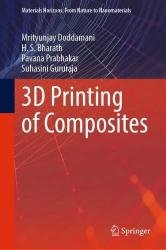3D Printing of Composites
- Добавил: literator
- Дата: 30-04-2023, 03:28
- Комментариев: 0
 Название: 3D Printing of Composites
Название: 3D Printing of CompositesАвтор: Mrityunjay Doddamani, H.S. Bharath, Pavana Prabhakar
Издательство: Springer
Год: 2023
Страниц: 140
Язык: английский
Формат: pdf (true), epub (true)
Размер: 43.2 MB
This book presents a unique approach to developing lightweight feedstock material for 3D printing of structural components for weight-sensitive structural applications across aerospace, automobile, and marine regimes. In addition to making wide feedstock materials choices available for AM industry, the content also presents a novel approach of 3D printing of lightweight core sandwich composites, all at once. It discusses the process of fused filament fabrication (FFF) as one of the most widely used additive manufacturing (AM) techniques to fabricate lightweight complex functional parts with zero tooling cost, lower energy, and reduced material consumption. The chapters presented in this book deal with a special class of lightweight feedstock material development, synthesis of the developed filaments, optimization of 3D printing parameters on a commercially available FFF-based printer, mechanical and dynamic property investigations of prints, and finally demonstration of 3D-printed industrial-scale lightweight components. This book guides students, researchers, and industrial professionals in lightweight materials design and development.
Compared to traditional processing methods, 3D printing enables the creation of components without compromising the strength-to-weight ratio. 3D printed SF-based prints and sandwiches open the possibility of more direct industrial applications for geometrically difficult items. Components manufactured with traditional fabrication processes, such as 3D printing syntactic foams, may be able to replace parts made with traditional fabrication techniques, which have limitations in terms of intricate geometries, longer production times, and higher costs. The adoption of 3DP over traditional processing has resulted in a variety of advantages, including the ability to create extremely specialized, complicated structures, cost savings, design freedom, and personalization. The printing method's precision, printing size, and the effect of external elements all influence the accuracy of the 3D printed composite. 3DP helps in printing intricate shapes and precise components with microscale details despite print resolution, surface polish, quality, and layer adhesion challenges. As a result, certain industrial scale components are 3D printed in this study to demonstrate the practicality of produced filaments in 3D printers by focusing on the component's weight. HDPE is the most widely utilized polymer in consumer goods manufacturing. Many present parts can benefit from GMB filled HDPE SFs, which provide a lightweight alternative while also reducing HDPE usage, resulting in a cost-effective proposal.
Contents:
Скачать 3D Printing of Composites
Внимание
Уважаемый посетитель, Вы зашли на сайт как незарегистрированный пользователь.
Мы рекомендуем Вам зарегистрироваться либо войти на сайт под своим именем.
Уважаемый посетитель, Вы зашли на сайт как незарегистрированный пользователь.
Мы рекомендуем Вам зарегистрироваться либо войти на сайт под своим именем.
Информация
Посетители, находящиеся в группе Гости, не могут оставлять комментарии к данной публикации.
Посетители, находящиеся в группе Гости, не могут оставлять комментарии к данной публикации.

